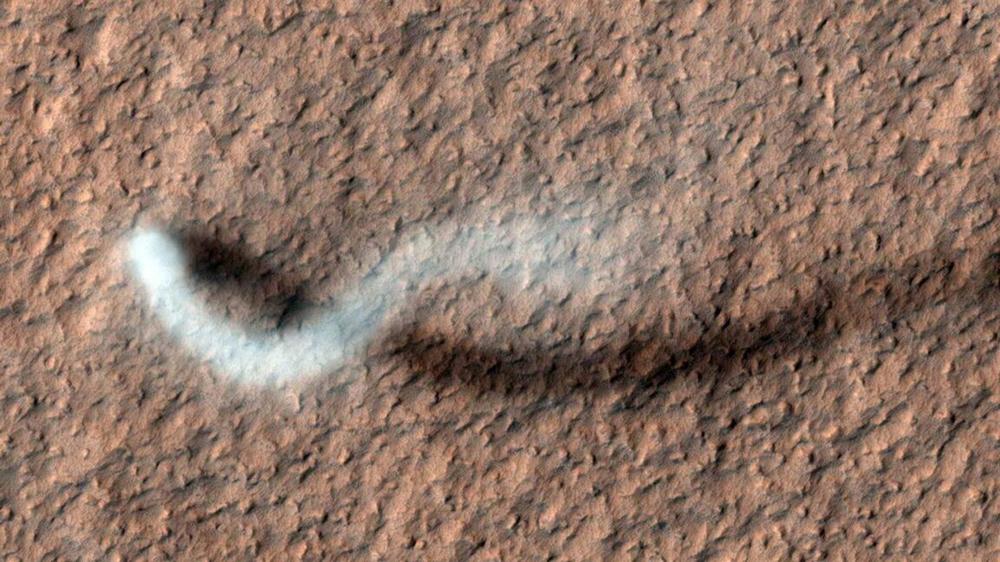Mars is cold, parched, and extremely dusty. Powerful gusts of wind kick up literal tons of reddish dust that often takes the form of whorls known as dust devils. These winds also shroud the planet in dust by lifting material from the surface and blowing it into the atmosphere (what little Mars has left of an atmosphere), sometimes creating dust storms that rage for days.
Researcher Valentin Bickel wanted to know just how intense winds can be on the Red Planet. Using data obtained by the Mars camera CaSSIS (Color and Stereo Surface Imaging System), the ExoMars Trace Gas Orbiter, and stereo camera HRSC (High Resolution Stereo Camera) on board ESA orbiter Mars Express, he and his team used deep learning to analyze stereo images that were taken seconds apart at the same location. These images can track the motion of dust devils, and the researchers use them to infer how the winds behind the dust devils move and lift dust from the surface. That dust goes on to have a big influence on the Maritan weather.
Bickel, of the Center for Space and Habitability at the University of Bern, noticed that the tumultuous Martian winds are even faster than previous observations had made them out to be. They carry more dust than was previously thought. “Our observations show that strong near-surface winds are abundant on Mars and play an important role in atmospheric dust sourcing, directly informing more accurate models of Mars’ atmosphere, weather, and climate,” the researchers said in a study recently published in Science Advances.
Dust to dust
On Mars, copious amounts of dust influence both surface and atmospheric processes. Particles floating in the atmosphere are capable of doing everything from causing temperature changes to altering atmospheric dynamics in a way that can then set off immense dust storms. Dust that settles often modifies surface features, including in notable cases like the dark streaks on dry Martian slopes. Whether anything ever lived on Mars is still unknown, but dust could have affected its viability by carrying nutrients around and offering protection from solar radiation.
Where does all this dust come from? It’s thought to be the result of erosion caused by the winds. Because the Martian atmosphere is so thin, dust particles can be difficult to move, but larger particles can become more easily airborne if winds are turbulent enough, later taking smaller dust motes with them. Perseverance and previous Mars rovers have mostly witnessed wind vortices that were associated with either dust devils or convection, during which warm air rises.
CaSSIS and HRSC data showed that most dust devils occur in the northern hemisphere of Mars, mainly in the Amazonis and Elysium Planitiae, with Amazonis Planitia being a hotspot. They can be kicked up by winds on both rough and smooth terrain, but they tend to spread farther in the southern hemisphere, with some traveling across nearly that entire half of the planet. Seasonal occurrence of dust devils is highest during the southern summer, while they are almost nonexistent during the late northern fall.
Martian dust devils tend to peak between mid-morning and midafternoon, though they can occur from early morning through late afternoon. They also migrate toward the Martian north pole in the northern summer and toward the south pole during the southern summer. Southern dust devils tend to move faster than those in the northern hemisphere. Movement determined by winds can be as fast as 44 meters per second (about 98 mph), which is much faster than dust devils move on Earth.
Weathering the storm
Dust devils have also been found to accelerate extremely rapidly on the Red Planet. These fierce storms are associated with winds that travel along with them but do not form a vortex, known as nonvortical winds. It only takes a few seconds for these winds to accelerate to velocities high enough that they’re able to lift dust particles from the ground and transfer them to the atmosphere. It is not only dust devils that do this—the team found that even nonvortical winds lift large amounts of dust particles on their own, more than was previously thought, and create a dusty haze in the atmosphere.
Bickel and his team think that the northern hemisphere is the main source of dust. Other sources, which have not been focused on in the past, are Daedalia Planum, active mostly during the northern spring and summer, and Sinai Planum, active during the southern spring and summer. Regions such as Arabia and Elysium are thought to be devoid of dust devils because they are dust sinks—reservoirs of dust that are not reached by the wind.
Occurrence of dust devils can also affect missions to Mars. As ESA’s ExoMars rover prepares to launch in 2028 and land in Oxia Planum, which is located in the northern hemisphere, scientists monitoring it on Earth should expect dust devils here and there—slightly more than InSight experienced when it landed near the Martian equator in Elysium Planitia. Excess dust can mess with solar panels and other hardware, but once on the planet’s surface, ExoMars will also be in a position to observe both vortical and nonvortical winds and how they lift and carry dust.
Until then, CaSSIS and HRSC will continue to monitor dust devils and the motion of winds and dust on Mars. As Bickel said in the study, “Integrated and spatiotemporally resolved monitoring—and possibly forecasting—of Mars’ atmospheric dynamics will be vital for future robotic—and specifically human—missions to Mars.”
Science Advances, 2025. DOI: 10.1126/sciadv.adw5170

 LinkedIn is making it easier to search for people with AI
LinkedIn is making it easier to search for people with AI